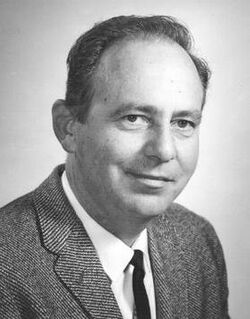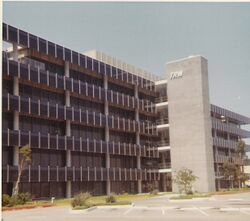Biography:James L. Buie
James L. Buie | |
|---|---|
 Buie, c. 1964 | |
| Born | 1920 Hollywood, California |
| Nationality | |
| Citizenship | |
| Alma mater | University of Southern California |
| Known for | TRW Inc. transistor-to-transistor logic (TTL) transistor-coupled transistor logic (TCTL) |
| Awards | The United States Distinguished Flying Cross |
| Scientific career | |
| Fields | Electrical Engineering |
| Institutions | TRW Inc. Pacific Semiconductors (PSI) Ramo-Woolridge Corporation |
James L. Buie (1920 – September 25, 1988) was an American scientist and inventor who worked for TRW Inc. He refined and developed electronic circuitry to the integrated circuit level. This led to the beginning of the integrated circuit industry.[1]
Early life
Buie was born in 1920 in Hollywood, California.[2] He served in World War II as an airplane pilot and became a lieutenant commander during his service.[2]
Career
Buie was an electrical engineering graduate of University of Southern California receiving a BSEE in 1950.[3] Buie's first job was at Pacific Semiconductors (PSI) in Culver City, California in 1951. He worked on transistor circuitry as related to diodes and resistors.[4] He was next employed by Ramo-Woolridge Corporation in 1954.[2] Ramo-Woolridge joined with Thompson Automotive Group in 1958 and eventually Thompson-Ramo-Woolridge became known as TRW Inc. Buie was a senior scientist and one of the organizers for TRW's Microelectronics Center that formed in 1963.[5] He headed TRW's large scale integration LSI Products Division in 1977.[2]
Buie invented transistor-to-transistor logic circuitry ("TTL") in 1961 leading to the development of the integrated circuit industry.[1][2][6][7][8][9][10] Buie's technology technique was originally known as transistor-coupled transistor logic – TCTL.[11] The TTL electronics invented by Buie became the electronics industry standard for two decades.[12] The first commercial integrated circuit products using the TTL technology were made by Sylvania in 1963 and known as the Sylvania Universal High-Level Logic family.[13][14]
Texas Instruments introduced integrated circuits for military applications in 1964. Buie's technology pioneered the development of microelectronics for man-made satellites used in space for the aerospace industry.[15] The integrated circuit technology was used extensively in the 1970s and 1980s in computers, communications, and military equipment.[15] TRW licensed the new technology to other companies to use in data processing and communications electronics. The TTL integrated circuit technology is still used in the electronics industry today.[1]
Innovations and inventions

His innovations in microelectronics included dielectrically isolated integrated circuits, single-chip parallel multipliers, single-chip analog-to-digital converters, and triple-diffused bipolar devices.[2] Some of his inventions are as follows:
- Temperature-compensated direct current transistor amplifier US 2867695 A – Apr 12, 1954
- Compound transistor US 2985804 A – Filing date Feb 8, 1960, Publication date May 23, 1961
- Coupling transistor logic and other circuits US 3283170 A – Filing date Sep 8, 1961, Publication date Nov 1, 1966
- Buie transistor technology patent continuation of Transistor Technology US 3233125 A – Filing date Apr 23, 1963
- Electrode lead for semiconductor active devices US 3475665 A – Filing date Aug 3, 1966
- Process of manufacture of semiconductor product US 3768157 A – Filing date 31 Mar 1971
Other patents of Buie are "Bipolar transistor construction method" (# 3981072 of 12/6/1974) and "Read-only memory construction and related method" (#4546456 of 6/8/1983).[16]
Societies
Buie was elected a fellow of the Institute of Electrical and Electronics Engineers in 1973.[1]
Awards
Buie was awarded the United States Distinguished Flying Cross in World War II for action during May 26–31, 1944.[17]
Retirement and death
Buie retired from TRW in 1983.[2] He died in Panorama City September 25, 1988, from emphysema.[1]
References
- ↑ 1.0 1.1 1.2 1.3 1.4 "James L. Buie, 68; Scientist, Inventor". Los Angeles Times (Los Angeles, California). September 28, 1988. http://articles.latimes.com/1988-09-28/news/mn-2621_1_james-l-buie. "Sep 28, 1988 – James L. Buie, whose many patents included one for electronic logic devices that led to the start of the integrated circuit industry, has died."
- ↑ 2.0 2.1 2.2 2.3 2.4 2.5 2.6 Lee, J. A. N. (2013). "Computer Pioneers". IEEE Computer Society. http://history.computer.org/pioneers/buie.html. "While working for TRW, Inc., Los Angeles, in the early 1960s, Buie developed and patented TTL circuitry, which became the dominant IC technology in the 1970s and early 1980s."
- ↑ "Independent inventions of TTL". Computer History Museum. http://www.computerhistory.org/atchm/the-rise-of-ttl-how-fairchild-won-a-battle-but-lost-the-war/.
- ↑ New in Integrated Circuits: Transistor-Coupled Logic, Hayden Publishing Company, 1961, p. V9_Part4_p2, https://books.google.com/books?id=OD1JAQAAIAAJ&q=%22James+L.+Buie%22+transistor+integrated&dq=%22James+L.+Buie%22+transistor+integrated&hl=en&sa=X&ved=0CBwQ6AEwAGoVChMI9cXarLqSyQIVCG4mCh3QGQX-, retrieved November 15, 2015
- ↑ Frequency Technology. Frequency, Inc.. 1970. p. 9. https://books.google.com/books?id=aJI7AAAAMAAJ.
- ↑ "1963 – Standard Logic IC Families introduced". Computer History Museum. 2014. http://www.computerhistory.org/semiconductor/timeline/1963-TTL.html. "Patented by James Buie of Pacific Semiconductor in 1961, TTL (Transistor Transistor Logic) emerged as the most popular logic configuration of the next two decades."
- ↑ Electronics. 53. McGraw-Hill Publishing Company. 1980. https://books.google.com/books?id=gUdWAAAAMAAJ. "The logic known today as standard transistor-transistor logic, or TTL, evolved from work done at several sources, but can be traced to James L. Buie, an IC designer at Pacific Semiconductors, who had devised in 1961 a better coupling technique that isolated stages with coupling transistors."
- ↑ Computer Design. volume 21. Computer Design Publishing Corporation. September 1982. p. 93. https://books.google.com/books?id=V5I_AQAAIAAJ. "James L. Buie (TRW) For the development of reliable high performance integrated circuits."
- ↑ House & Price 2009, p. 579.
- ↑ Burghartz 2013, p. 228.
- ↑ "THE INTEGRATED CIRCUIT". Fazano. 2015. http://www.fazano.pro.br/ing/indi111.html. "In early sixties, Pacific Semiconductor Company launched in the market the TTL logic or Transitor-Transistor Logic, as well as through the researches of the IC designer James L. Buie had devised a better coupling technique known as transistor-coupled transitor logic – TCTL."
- ↑ John Keller (December 18, 2011). "Former TRW Space Park, now Northrop Grumman, designated as historic site for electronics and aerospace work". Military & Aerospace Electronics. http://www.militaryaerospace.com/articles/2011/12/former-trw-space-park.html. "The TTL logic gate, which was the electronics industry standard for two decades, was invented by TRW's James L. Buie in 1961."
- ↑ "Logic Families (book review)". Better World Books. 2015. http://www.betterworldbooks.com/logic-families-id-1155216660.aspx. "TTL was invented in 1961 by James L. Buie of TRW, "particularly suited to the newly developing integrated circuit design technology." The first commercial integrated-circuit TTL devices were manufactured by Sylvania in 1963, called the Sylvania Universal High-Level Logic family."
- ↑ "The Fascinating Transistor-transistor Logic (TTL) Clock!". CircuitGeek. 2008. http://www.scienceprog.com/the-fascinating-transistor-transistor-logic-ttl-clock/.
- ↑ 15.0 15.1 Lee 1995, p. 145.
- ↑ "Patents by Inventor James L. Buie". Justia. 2015. http://patents.justia.com/inventor/james-l-buie.
- ↑ "Hall of Valor: Distinguished Flying Cross: James L. Buie". 2015. http://valor.militarytimes.com/recipient.php?recipientid=308384.
Sources
- Burghartz, Joachim N. (2013). Guide to State-of-the-Art Electron Devices. John Wiley & Sons. ISBN 978-1-118-51753-6. https://books.google.com/books?id=pna3BnwW-6EC&pg=RA2-PT430.
- House, Charles; Price, Raymond (2009). The HP Phenomenon: Innovation and Business Transformation. Stanford University Press. ISBN 978-0-8047-7261-7. https://books.google.com/books?id=OsTnDv6d2DwC&pg=PA579.
- Lee, John A. N. (January 1995). International Biographical Dictionary of Computer Pioneers. Taylor & Francis. ISBN 978-1-884964-47-3. https://books.google.com/books?id=ocx4Jc12mkgC&pg=PA145.
External links


